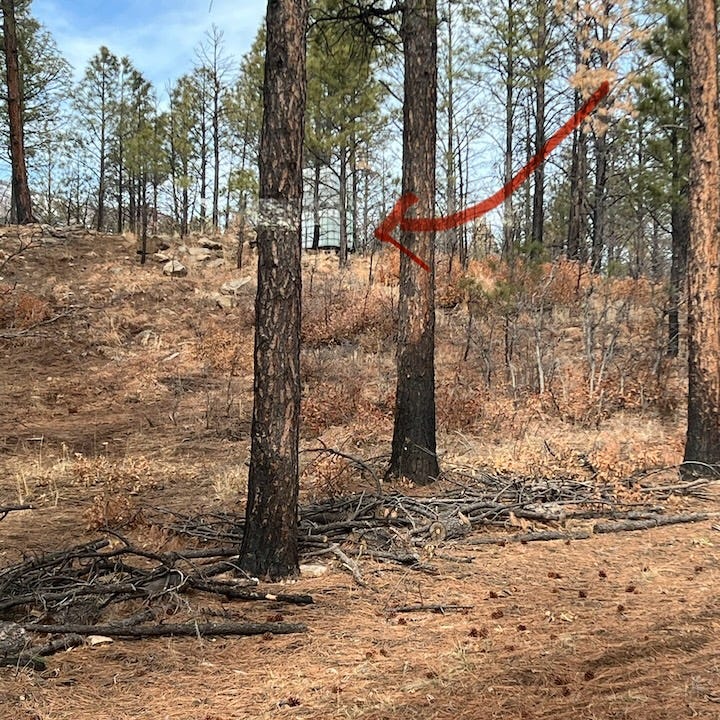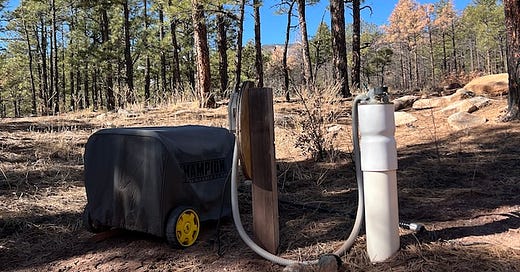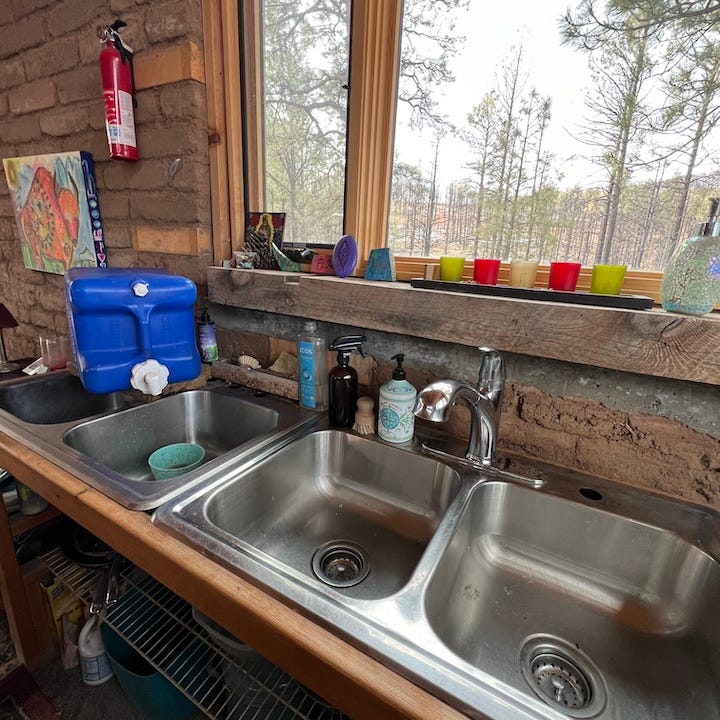I stood clutching my paperwork, staring at the sign on the door. It was 12:05 pm on a Wednesday. The white square had a clock with the little red arrow pointing to 1 pm and the words: Back at 1 pm.
Noooooooo! I had driven an hour to deliver the paperwork in my hand, only to discover the office closed for lunch.
Sigh.
I shook my head, laughed, then headed to get lunch and wait for the New Mexico Office of the State Engineer to re-open.
The paperwork I was carrying around in a manila envelope was two-fold. First: a change of ownership for the wimpy well on the land I steward (more about that later). Second: a request to drill a new well. Both were filled out in triplicate, as requested, and one set was notarized – incorrectly, for the second time, I would soon enough learn.
My dance with the State Engineer's office started two weeks earlier when I received a short text from my friend Ernesto: “Christine hit water at 160 feet.”
“Yay!” I typed back. Christine was my neighbor to the north-east. In our area 160 feet for a well was shallow. Most of the wells in our area are 350 to 400 feet deep.
I didn't think much about the text until about 4 am, when I sat up in bed, horrified by a realization.
If Christine was having a well drilled, that meant that Red Top Drilling was in the area.
If Red Top Drilling was in the area, that meant they hadn't called me.
If they hadn't called me, that meant I was not going to get a new well drilled.
A year and ½ ago, after the wildfire, I called Red Top and asked if they could come drill a second well for me.
When I shared my address outside of San Geronimo I was told: “We won't be in your area for another two years.”
“Two years?!?” I said. I took a deep breath. Okay. Two years.
“Then put me on the list, please.”
After my 4 am wake up I managed to get myself back to sleep, and at 9 am called Red Top Drilling and spoke to Stephanie, who pleasantly told me that she had indeed called me and left two messages about the driller being in my area: One in November and one in December.
“There are no calls on my phone from you,” I said, feeling panicky. Could I have missed both those calls? But as I scrolled through my voicemails I confirmed: I had never received a call, let alone a message, from Red Top Drilling.
“Well, we have two numbers for you...” Stephanie told me, obviously looking at her notes. One of the numbers she shared was my number, and the second one was a number I had never heard of before.
Sigh.
“What can we do?” I asked Stephanie. “I did have my name on the list.”
I could feel her thinking.
“Okay, I think we could drill for you if you take the paperwork to the State Engineer today. If you can get the well tag by Friday we can do the site inspection and drill next week.”
“Thank you! I'll call you back.”
There was only one glitch to this solution: I was in Mexico for another week.
Let's back up and talk about the current well, and why I am so keen to drill a second one.
Our current well was drilled by Red Top Drilling in 2007, and was very obviously not “witched.” Witching is when someone uses dowsing rods to find underground water. It appears the previous owner, Rose Bramble*, had the drilling rig drive just past the property line and drill the well at the first flat spot, right next to the road.
Here are things I've also learned through talking to neighbors and looking at the online map which tracks all wells and waterways throughout the State of New Mexico:
My neighbors have wells that run between 30 to 50 gallons per minute.
I am upstream and up the water shed of all my neighbors, bordered against thousands of acres of National Forest.
The well on my property, until recently owned by the truly named Rosemary Bramble aka Rose Bramble, ended up being 360 feet deep, a four-inch hole drilled through green and grey shale. The water rose to 40 feet from the surface. I know all these details from the paperwork I received when I bought the property.
This well pumps about 1 gallon a minute.
Sad face.
I can't tell you how many times I have said over the years since I bought the property: “Oh why, oh why didn't they witch the well?”
When I hung up from talking to Stephanie and Red Top Drilling I called Franklin, my dear friend, co-conspirator, and retired contractor genius at all things building and land-related. “We have a situation,” I told him.
He is very used to situations.
After explaining the issue, he said, “I know exactly where the State Engineer's office in Santa Fe is. I can bring the paperwork in today.”
I emailed the well drilling request paperwork to him so he could print it out in triplicate. We agreed he would sign his name and my name so we could both work with the driller.
Then he drove an hour to Santa Fe.
The State Engineer looked at the paperwork, called up the coordinates for the land, and handed Franklin back the paperwork.
The problem? The well on the property was stilled owned by Rose Bramble. No one ever told me we would have to transfer it. This was done by more paperwork. In triplicate. And there was a choice to be made: Either I would have to close down Rose Bramble's well by having the driller pour concrete into to it up to the very top, or I would have to apply for a supplemental well. If I chose the supplemental well I would have to put a meter on both wells and give quarterly reports to the State Engineer's Office.
Aarrrgh.
After two more visits I did finally submit the paperwork requesting a new well, but apparently the rules changed the day before I finally got the notary correct and everything in order.
Apparently my land was re-zoned into an artesian aquifer region. 30 miles away, near Hermit's Peak, someone drilled a well where the water came up to the surface. That is considered an artesian well... basically a spring that you don't have to go down to get the water, the water comes up to you.
Instead of it taking two days to get the tag for the new well back from the State Engineers, it is going to take a month.
Nooooooo!
Sigh.
Thanks to Franklin's wizardry and skill, we do have an adequate, if patch-worked, water system at the ranch connected to our low-flow Rose Bramble well.
Three years ago or so Franklin did some sleuthing and bought a $150 120-volt pump on amazon.com. We dropped the pump about 60 feet down the well shaft, then connected it to a faucet at the well-head and an electrical box with a plug.
The first time we hooked the pump up to a generator and brown sulfury smelling water came spraying out the hose we all danced around yelling and crying “WE HAVE WATER!!!!”
While the water these days is much less brown and hardly smells, we can still only pump about 100 gallons of water at a time before the well is drained.
Today, the water that comes out of the faucet in the kitchen flows by gravity from one of the two 250-gallon tanks up the hill, pumped from our well through about 750 feet of various colored garden hoses.
To get water:
Uncover the squat, boxy gas generator. Pat its pretty yellow goodness. Make sure it has fuel.
Flip the choke, pull hard but gently on the cord to get it roaring to life.
Open the faucet at the well head.
Plug the well pump into the generator to start the well pump.
Walk up hill along the hose line, looking for leaks or breaks.
Visit the water tank to make sure water is flowing correctly through the hose at the top. Fist bump the tank lovingly. Good job, tank.
Watch the tank until it fills about 125 gallons, or walk back down the hill to the generator and listen for the sound to change so you know the well is depeleted for the day.
Turn off the faucet so water doesn’t siphon back into the well. Unplug the well pump. Turn off the generator.
Let the well rest for about 24 hours to replenish the water.
At a retreat last summer one of our kitchen crew washed dishes with high exuberance. They went through about 100 gallons of water a day, and three days into our retreat they came to me, puzzled at why there was no more water.
Even though I had shared with everyone that the water is limited, and pointed up to the tanks, when you are used to unlimited water steadily flowing from a tap no matter how much you use, it can be a challenge to grok that things like water are truly limited.

This is part of why I love bringing people up to the ranch; it is a respite from the city, a place of beauty, solitude and stillness. And it is also a place to learn the limitation of resources.
Which shifts us from taking things for granted to knowing they are holy.
When we start to understand how precious water, or electricity, or food really is we become truly present to how sacred it all is. And how quickly it could be gone.
We really do not realize how much we use when it seems unlimited.
Even the water from our city taps is precious, a limited resource. Water doesn't just come endlessly from a tap, just like food doesn't come from grocery stores.
Water comes from underground aquifers, reservoirs, reclaimed water, or from capturing rainwater.
From years of living in drought-stricken states I learned to turn the water on, rinse the dish, turn the water off to soap the dish, turn the water on to rinse it, and turn the water off while I put the dish onto the drying rack. It's become a habit, no matter where I am, to never leave water running.
Now in the winter, water up here is even more scarce. All the hoses to the well and water tanks are disconnected and drained for the winter so they don't freeze. I'm currently washing dishes with a five-gallon bright blue plastic dispenser with a white spigot. I heat a small amount of water on the wood stove, mix it with dish soap and cooler water into the largest bowl, and then start soaping up all the dishes. Then I rinse each quickly with water from the five-gallon jug. For the greasy pots and pans I first wipe down with paper towels which are then used to light the wood stove. I've been here three days and multiple meals and I've used about a gallon of water total for dishes.
Today I'm heading up to the land to meet Jarrad Isbell, the expert at Red Top Drilling, to assess where we should put the second well.
Since I don’t have the well tag back from the State Engineer’s Office the drilling rig will probably have to move out before we can drill, and I'll put myself on the list for when they are in our area again. Or perhaps they will still be here when we get the well tag from the State of New Mexico. We'll see. But at least we will get to witch where the next well will be drilled — I’m bringing my dowsing rods.
Then we wait. And hope for a strong, sweet water well when we can finally drill.








HeatherAsh after reading this i found a deep well (haha) of gratitude for the 12,000 gallon tank (buried about 4 feet in the earth) we put in at our ranch a few years back, with a timer so that in between cycling the well can rest. It replaced an aging 5,000 tank that was rusty and leaking that came with the original ranch purchase. We did drill 2 new wells in the past 2 years. This time we went solar and so the wells auto rest every time a cloud goes by (honestly they are that sensitive) and of course they regenerate at night. We firmly believe in the near future “they” will restrict our access to the water underneath the land we steward. Witch on!! Dig on!! And may you be blessed with flowing water 💦
Thank you HeatherAsh, for deepening my gratitude for water!